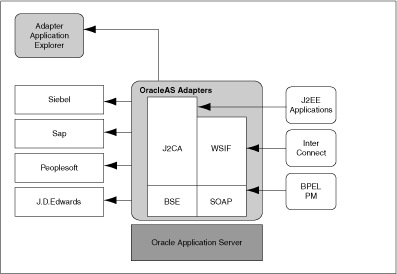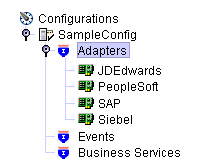|
Oracle® Application Server Adapter Concepts Guide
10g Release 2 (10.1.2) B14058-04 |
|
 Previous |
 Next |
|
Oracle® Application Server Adapter Concepts Guide
10g Release 2 (10.1.2) B14058-04 |
|
 Previous |
 Next |
Using packaged-application adapters, you can integrate Oracle Application Server with packaged applications such as J.D. Edwards and Siebel. These adapters include OracleAS Adapter for Peoplesoft, OracleAS Adapter for SAP R/3, OracleAS Adapter for Siebel, OracleAS Adapter for Oracle Applications, and OracleAS Adapter for J.D. Edwards.
This chapter describes the architecture of packaged-application adapters. It contains the following topics:
Packaged-application adapters can be deployed as J2EE Connector Architecture (J2CA) 1.5 resource adapters or as Web service servlets within the Oracle Application Server Containers for J2EE (OC4J) container. In addition to a J2CA interface, packaged-application adapters support the Web Service Definition Language (WSDL) and Simple Object Access Protocol (SOAP) interface. J2CA and Web service deployments of packaged-application adapters should have a repository project. In J2CA deployment, the resource adapter points to a repository project that can contain multiple back-end connection objects. The deployment descriptor, oc4j-ra.xml, points to the J2CA repository project and the connection name to access within the J2CA repository project. In the WSDL deployment, the WSDL repository project consists of a set of WSDL files that describe the adapter metadata.
|
Note: Only four packaged-application adapters, including OracleAS Adapter for SAP, OracleAS Adapter for Siebel, OracleAS Adapter for Peoplesoft, and OracleAS Adapter for J.D. Edwards, support WSDL and SOAP extensions in this release. The architecture of the OracleAS Adapter for Oracle Applications is similar to technology adapters. |
The architecture of packaged-application adapters consists of OracleAS Adapter Application Explorer (Application Explorer), J2CA 1.5 resource adapter, and Business Services Engine (BSE).
Figure 3-0 illustrates the architecture of packaged-application adapters:
Figure 3-1 Packaged-Application Adapters Architecture

This section describes the following components of the packaged-application adapter architecture:
Application Explorer is a Java swing-based design-time tool for configuring packaged-application adapters. Using Application Explorer, you can configure the back-end application connection, browse the back-end application schemas, and expose these schemas as adapter services. Application Explorer is shipped with packaged application-specific plug-ins for browsing the back-end application-specific metadata.
You can use Application Explorer to create repository projects for either OracleAS Adapter J2CA or BSE. Each repository project can consist of multiple back-end application connections. The schemas are represented as either XML Schema Definition (XSD) for the OracleAS Adapter J2CA interface or as a WSDL with SOAP binding.
Application Explorer works in conjunction with the BSE, which is deployed in the Oracle Application Server Containers for J2EE (OC4J) container of the Oracle Application Server. BSE uses SOAP as a protocol for accepting requests from clients, interacting with the back-end application, and sending responses from the back-end application back to clients.
Application Explorer is used to configure packaged-application adapters during design time. This tool is used to create a repository project for the J2CA 1.5 resource adapter, which contains a list of back-end connections. Application Explorer exposes back-end metadata as XSD and WSDL with J2CA extensions. The XSD metadata is used by OC4J application clients for integration through the J2CA Common Client Interface (CCI) Application Programming Interface (API). The WSDL with J2CA extension is used for integration with Business Process Execution Language for Web Services (BPEL) Process Manager. The BSE metadata can be defined as WSDL or SOAP.
Application Explorer is shown in Figure 3-2.
Example 3-1 Generating XML Request Schema for OracleAS Adapter for SAP
You can use Application Explorer to establish a connection for OracleAS Adapter for SAP. For this, you must first define a target to OracleAS Adapter for SAP, as shown in the following figures:
Figure 3-3 Selecting OracleAS Adapter for SAP

Figure 3-4 Defining a Target to OracleAS Adapter for SAP

After you explore the SAP business function library and select an object, you can use Application Explorer to create the XML request schema and the XML response schema for that function. To view the XML for each schema type, select the appropriate tab as shown in the following figure.
The run-time components of packaged-application adapters include J2CA 1.5 resource adapter, BSE, and servlet. The OC4J application clients use the CCI API to directly interface with the J2CA 1.5 resource adapter. In this release, OC4J supports J2CA 1.0 specification only and the CCI API can be used for calling J2CA Outbound Interactions only. The J2CA 1.5 resource adapter integrates with BPEL Process Manager through the Adapter Framework. During run time, Adapter Framework translates the BPEL Process Manager service requests to J2CA calls and back based on the adapter metadata (WSDL or J2CA extension) configured during design time.
During run time, the WSDL files generated during design time are consumed by the integrating components. For example, the BPEL Process Manager uses Adapter Framework to integrate the request-response service (J2CA outbound interaction) with a BPEL invoke activity and to publish adapter events to a BPEL receive activity. For more information about integrating with BPEL PM, refer to Chapter5, "Adapter Integration with BPEL Process Manager".
The OC4J application clients, such as servlet, EJB, and Java applications, use the CCI API to interface with the J2CA Adapter. For more information about integration with OC4J, refer to Chapter5, "Adapter Integration with OC4J".
Packaged-application adapters are deployed as J2CA 1.5 resource adapters within the OC4J J2CA container during installation. The adapter needs to be in the same OC4J container as BPEL Process Manager for integration.
You can integrate any Web service client with the BSE servlet. The BSE exposes the underlying back-end functionality as Web services, which can be either WSDL or SOAP. BPEL Process Manager can integrate with the BSE layer as well through WSDL and SOAP binding.
BSE is deployed as a servlet within the OC4J container during installation. BSE can be remotely located and need not be in the same container as the BPEL Process Manager.